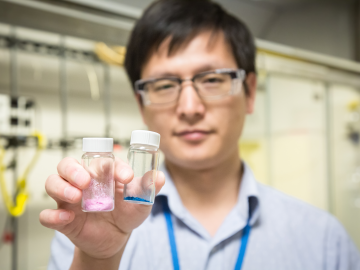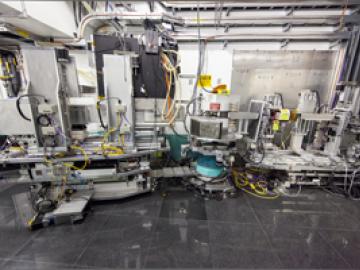Filter News
Area of Research
- (-) Chemical and Engineering Materials (4)
- (-) Climate and Environmental Systems (14)
- (-) Fuel Cycle Science and Technology (3)
- Advanced Manufacturing (34)
- Biological Systems (18)
- Biology and Environment (177)
- Biology and Soft Matter (5)
- Building Technologies (12)
- Chemistry and Physics at Interfaces (11)
- Clean Energy (522)
- Computational Biology (6)
- Computational Chemistry (5)
- Computational Engineering (5)
- Computer Science (19)
- Data (1)
- Earth Sciences (1)
- Electricity and Smart Grid (3)
- Energy Frontier Research Centers (14)
- Energy Sciences (5)
- Fossil Energy (3)
- Functional Materials for Energy (16)
- Fusion and Fission (54)
- Fusion Energy (17)
- Geographic Information Science and Technology (3)
- Isotope Development and Production (3)
- Isotopes (35)
- Materials (433)
- Materials Characterization (2)
- Materials for Computing (36)
- Materials Synthesis from Atoms to Systems (13)
- Materials Under Extremes (12)
- Mathematics (1)
- National Security (79)
- Neutron Data Analysis and Visualization (4)
- Neutron Science (190)
- Nuclear Science and Technology (74)
- Nuclear Systems Modeling, Simulation and Validation (3)
- Nuclear Systems Technology (1)
- Quantum Condensed Matter (4)
- Quantum information Science (9)
- Reactor Technology (1)
- Renewable Energy (4)
- Sensors and Controls (5)
- Supercomputing (311)
- Transportation Systems (11)
Media Contacts

Oak Ridge National Laboratory researchers have produced the next generation of the National Hydropower Map – a visualization tool that provides updated statistics on overall capacity and performance on the nation’s hydropower fleet. The map is part of the lab’s National Hydropower ...

For early career researchers, a fellowship can be a valuable foot in the door, exposing them to the opportunity to gain experience in areas of science and technology of national importance.

Crude oil refinement can be an extremely costly chemical process. In an effort to reduce energy and cost demands, Oak Ridge National Laboratory researchers Anibal Ramirez-Cuesta and Stuart Campbell are collaborating with University of Nottingham (UK) researchers to develop metal-orga...

Blowing bubbles may be fun for kids, but for engineers, bubbles can disrupt fluid flow and damage metal.

depth, population-based approach to identifying such mechanisms for adaptation, and describes a method that could be harnessed for developing more accurate predictive climate change models. For the U.S. Department of...

The Spallation Neutron Source at the Department of Energy’s Oak Ridge National Laboratory broke records for sustained beam power level as well as for integrated energy and target lifetime in the month of June.

The American Conference on Neutron Scattering returned to Knoxville this week, 12 years after its inaugural meeting there in 2002.

Thomas Wilbanks and Benjamin Preston, both of the Climate Change Science Institute (CCSI) at Oak Ridge National Laboratory (ORNL), are among the 309 coordinating lead authors of the Intergovernmental Panel on Climate Change’s (IPCC’s) Working Group II (WG II) report.

Carbon dioxide in the atmosphere may get the lion’s share of attention in climate change discussions, but the biggest repository of carbon is actually underfoot: soils store an estimated 2.5 trillion tons of carbon in the form of organic matter.

Former Energy Secretary Steven Chu mixed his Wigner Distinguished Lecture on Feb . 12 with a description of his current research at Stanford and his outlook on energy policy and climate change.




